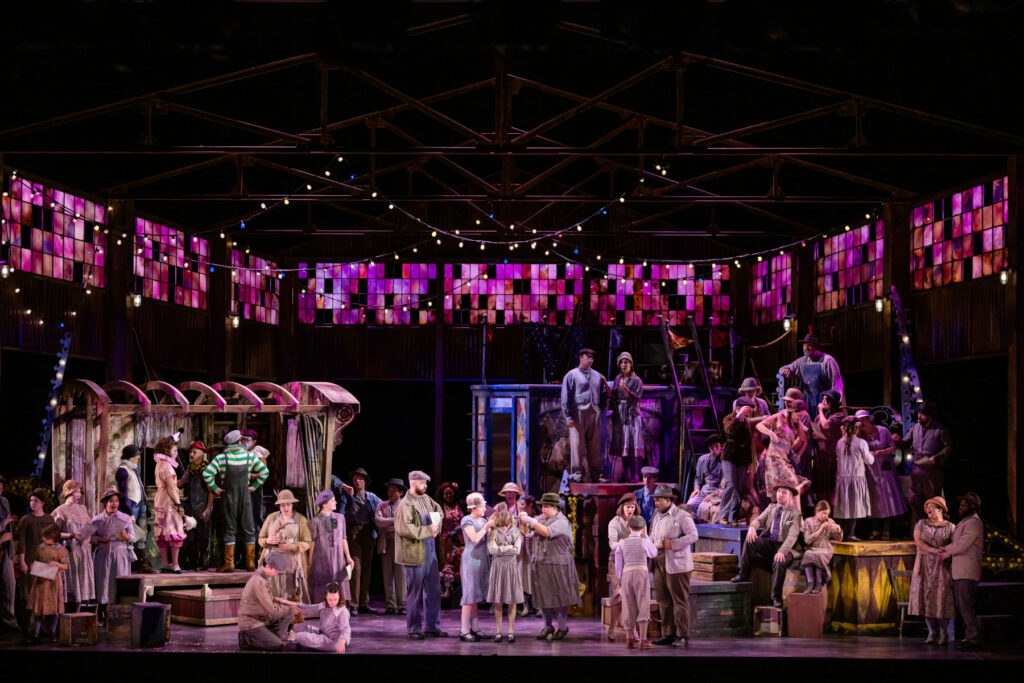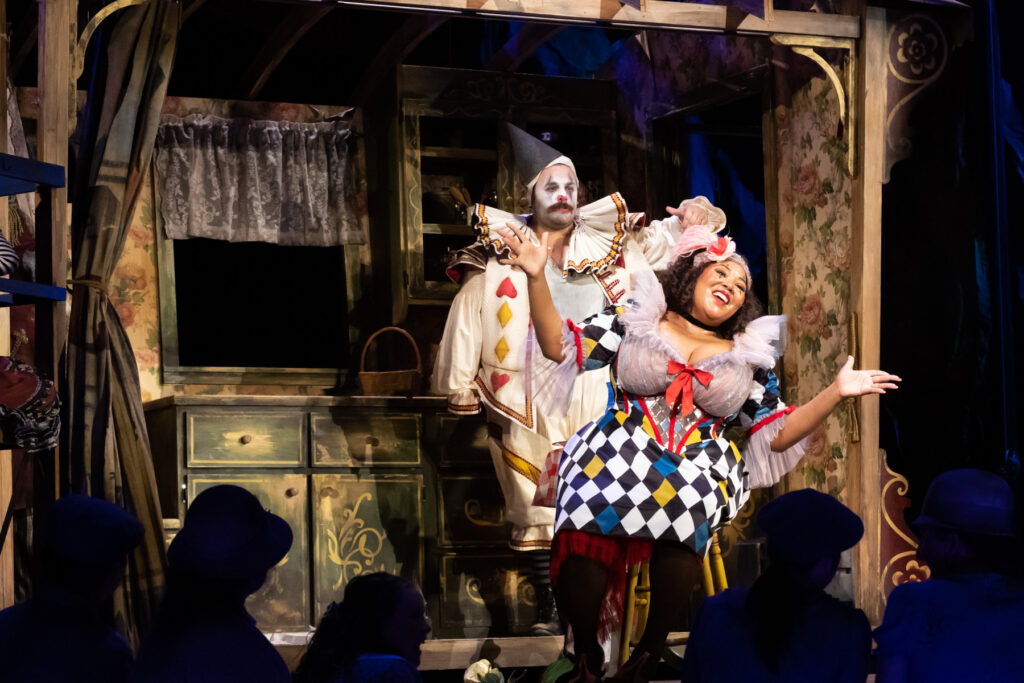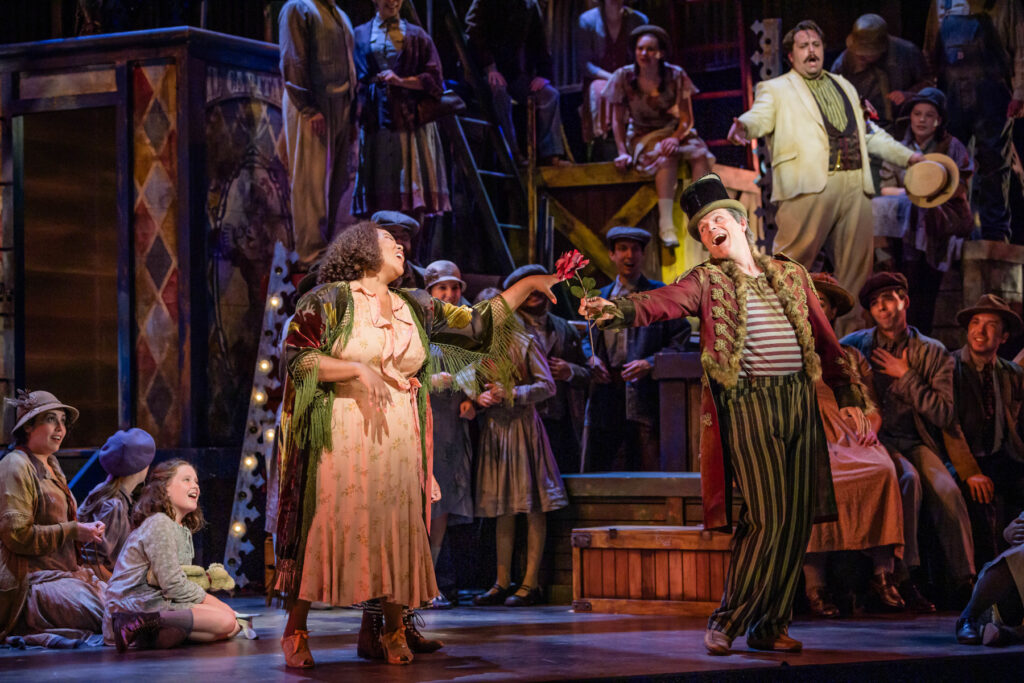Shortly before the curtain rose on a splendid production of the evergreen favorite, Pagliacci, we were informed that Glimmerglass Music Director Joseph Colaneri was indisposed and would not conduct.
That the performance not only went on but was entirely satisfying was owing to the remarkably fine leadership by the cover, young Assistant Conductor, Christian Olson, who seemed completely prepared and abundantly skilled to step into this high profile assignment at one of America’s most prominent summer festivals. His total success earned him a prolonged, vociferous ovation. But a whole lot happened before that well-deserved acclamation.
Director Brenna Corner has conceived her effective staging as Tonio’s traumatized flashback to the tragic carnage and horrific series of events that he maliciously set in motion. It begins in silence in the 1970’s in a cluttered warehouse near train tracks, as established by sounds of locomotives passing nearby. Aging Tonio enters as if needing to revisit the articles contained in storage. As he slowly pulls away huge drop cloths, he reveals the large trailers and copious crates of Canio’s traveling troupe. When the rolling stage is revealed, the downbeat is given and Tonio regales us with information about the show we are about to see (in which he plays Taddeo), which is actually a flashback to the 1930’s dustbowl era, when the crimes of passion were perpetrated.

Ms. Corner has followed through on her concept with admirable clarity of purpose. She has breathed freshness into this familiar piece without distracting us from its tried and true assets. Once the opera proper begins, the storytelling is vividly in the present, teeming with life. The framing of the warehouse structure contains well-motivated movement, richly detailed immediacy of risk and danger, well realized characters with believable relationships, and an ever shifting diorama of stage pictures that used countless levels that allowed the large chorus to cavort about like musical mountain goats. Without distorting the libretto one bit, Corner greatly enriched the subtext by having a mute child actor (the wonderful Ethan Chen) play Canio and Nedda’s young son. This added a persuasive reason for Nedda to have stayed with her abusive husband. By the time the 1930’s Canio calls out for Taddeo/Tonio just prior to the “on stage” denouement, that actor is gone, already returned “Back to the Future,” as the piece reverts to the solitary tortured old survivor Tonio in 1970, among the ruins with his unalterable past. This was powerful, impactful imagery, indeed. I also should note that Eric Sean Fogel’s well-integrated, natural choreography enlivened a number of entertaining moments.
James Rotondo’s magnificent set design was impressively rich in detail and scope. Everything about the playing space felt right, and the wagons and crates were effectively dressed with a knowing eye. The distressed fading of colors of the units was like a glowing patina of faded glory. Mr. Rotondo’s profusion of playing levels provided a director’s dream and the entire effect was almost that of a cinematic epic at times. The boxy walls of the storage shed are topped with rows of window panels, that took on the festive look of stained glass when lit so ingeniously by Robert Wierzel. This was some of Mr. Wierzel’s finest work, alternating festive and carnival looks (complete with strings of party lights that extended into the audience) with more menacing, hotter washes that conveyed the dangerous sexual tension that propels the action. Wierzel achieved some adroit accent touches, such as tightly pointing up and isolating the spy Tonio observing the adulterers, and then the apprehensive Silvio at the “performance,” omnipresent but wonderfully understated.

Similarly, Eric Teague’s parade of costumes was spot-on and splendidly realized, from the “offstage” lower-middle class 30’s garb for the actors and town folk, to the traditional Commedia costumes for the “performers” presenting the play within the play. The latter were hugely inventive variations on the stock designs of the period and provided a heady counterbalance to the dark underbelly of the intensifying tragedy. Tom Watson has been a busy lad, having lent his admirable expertise in hair and make-up design to each production this summer, and once again, his artistic touch was invaluable in completing “the look.”
The singing was of the highest order, beginning with the rock solid, theatrically demonstrative Prologue, delivered with easy power, commanding presence, and well-calculated panache by baritone Troy Cook. Having enchanted us as Major General Stanley in Pirates the night prior, Mr. Cook made an awesome about face on this occasion, and presented a debauched, willful Tonio, whose libidinous revenge motivates the action, all the while unleashing torrents of virile, assertive phrases that were as notable for their ringing power as they were for their tonal beauty.

Robert Stahley has all the goods to deliver a persuasive account of the world-famous central role of Canio: a gleaming, buzzy tenor of suitable Italianate coloring and adequate heft for the money moments, and an appealing stage manner that unfolds from the seemingly easy going, ingratiating entertainer, through wrenching doubts about his wife’s fidelity, to the final unraveling into unhinged vengeance. Mr. Stahley knows the role to a fare-thee-well, and how to make it land every moment, all the while singing with thrilling, refulgent effect. His generous vocalizing held nothing back, and while I sometimes feared he was right at the very limit of his firepower, there is no question his was a resoundingly successful performance.
As the trapped wife Nedda, Amber R. Monroe was nigh unto perfection, her plush, creamy, sizable soprano treating us to a truly memorable, effortless version of Stridono lassú; and then just getting even better and better. For sheer gorgeous sound, stylistic acumen, and engaging acting, Ms. Monroe is as fine a Nedda as I have experienced. One of the most radiant stretches of the evening’s glories was her glamorous vocal partnering with Jonathan Patton for a beauteous rendition of the extended Nedda-Silvio love duet. The lanky, youthful Mr. Patton’s buzzy, surging baritone was achingly plangent, and his nuanced account was distinguished. Fran Daniel Laucerica made every moment count in his animated, personable role assumption as Beppe. Mr. Laucerica’s sweetly shining tenor served up the Serenade as a witty, tuneful delight.
That all these highly professional creative elements were already knit into this Pagliacci Dream Team had to have made Maestro Olson’s assuming the baton a good deal easier, but still, there is no doubt the evening’s top triumph was his. And for good reason. Not only did Olson elicit assured, nay, thrilling playing from the excellent Festival Orchestra, but he sensitively partnered with a superlative cast of soloists and phrased with them as one, all the while also commanding the very large choral scenes (nicely prepared by Chorus Master Katherine Kozak) with enthusiasm and precision. Based on this impressive achievement, and if the appreciative audience has any say, Christian Olson deserves a bright future.
This affecting Pagliacci certainly was an accomplished re-telling of this beloved tragic tale, but on this night, it was also a joyous sleeper success. Bravo, Maestro Olson!
James Sohre
Pagliacci
Music and Libretto by Ruggero Leoncavallo
Canio: Robert Stahley; Nedda: Amber R. Monroe; Tonio: Troy Cook; Silvio: Jonathan Patton; Beppe: Fran Daniel Laucerica; Peasant #1: Geoffrey Schmelzer; Peasant #2: Ajit Persaud; Clown Performer and Consultant: Holly Adams; Commedia Trio: Kailee Brandt, Scout Santoro, Peter Murphy; Son of Nedda and Canio: Ethan Chen; Conductor: Christian Olson; Director: Brenna Corner; Set Design: James Rotondo; Costume Design: Eric Teague; Lighting Design: Robert Wierzel; Hair and Makeup Design: Tom Watson; Choreographer: Choreographer: Eric Sean Fogel; Chorus Master: Katherine Kozak
Top photo by Sofia Negron.